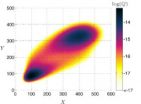(Press-News.org) Neutron stars, the extraordinarily dense stellar bodies created when massive stars collapse, are known to host the strongest magnetic fields in the universe -- as much as a billion times more powerful than any man-made electromagnet. But some neutron stars are much more strongly magnetized than others, and this disparity has long puzzled astrophysicists.
Now, a study by McGill University physicists Konstantinos Gourgouliatos and Andrew Cumming sheds new light on the expected geometry of the magnetic field in neutron stars. The findings, published online April 29 in Physical Review Letters, could help scientists measure the mass and radius of these unusual stellar bodies, and thereby gain insights into the physics of matter at extreme densities.
Some previous theoretical studies have suggested that the magnetic field of a neutron star should break into smaller loops and dissipate as the star ages – a phenomenon known as "turbulent cascade." Yet, there are several "middle-aged" neutron stars (roughly one million to a few million years old) that are known to have relatively strong magnetic fields, leaving scientists at a loss to reconcile the theoretical models with actual observations.
To better understand how the magnetic field changes as a neutron star ages, Gourgouliatos and Cumming ran a series of computer simulations. These showed the magnetic field evolving rapidly at first, in line with previous predictions. But then the evolution took a surprising turn: in all the simulations, no matter what the magnetic field looked like when the neutron star was born, the field took on a particular structure and its evolution dramatically slowed.
"A cascade in a magnetic field is akin to what happens when you add cream to your coffee and stir it: the cream rapidly gets broken up into pieces and mixes into the coffee," Cumming explains. "The original prediction was that neutron star crusts would do the same to their magnetic fields; so if you could walk around on the surface with a compass trying to walk towards magnetic north, you would end up walking around in random directions. Instead, we find in these new simulations that the magnetic field actually remains quite simple in structure – as if the cream refused to mix into the coffee – and you could, indeed, use a compass to navigate around on the surface of the star."
The McGill researchers call this final magnetic-field configuration the "Hall attractor" state, after the so-called Hall effect, which is thought by astrophysicists to drive magnetic field evolution in neutron-star crusts. "This result is also significant because it shows that the Hall effect, a phenomenon first discovered in terrestrial materials and which is thought to help weaken a magnetic field through turbulence, can actually lead to an attractor state with a stable magnetic-field structure," Gourgouliatos says.
INFORMATION:
The research was supported by the Centre de Recherche en Astrophysique du Québec and the Natural Sciences and Engineering Research Council of Canada.
"Hall Attractor in Axially Symmetric Magnetic Fields in Neutron Star Crusts", Konstantinos N. Gourgouliatos and Andrew Cumming, Physical Review Letters, published 29 April 2014.
http://journals.aps.org/prl/abstract/10.1103/PhysRevLett.112.171101
Neutron star magnetic fields: Not so turbulent, after all?
New findings could help advance understanding of matter at extreme densities
2014-05-06
ELSE PRESS RELEASES FROM THIS DATE:
Detecting fetal chromosomal defects without risk
2014-05-06
Chromosomal abnormalities that result in birth defects and genetic disorders like Down syndrome remain a significant health burden in the United States and throughout the world, with some current prenatal screening procedures invasive and a potential risk to mother and unborn child.
In a paper published online this week in the Early Edition of PNAS, a team of scientists at the University of California, San Diego School of Medicine and in China describe a new benchtop semiconductor sequencing procedure and newly developed bioinformatics software tools that are fast, accurate, ...
Working to cure 'dry eye' disease
2014-05-06
WASHINGTON D.C. May 6, 2013 -- The eye is an exquisitely sensitive system with many aspects that remain somewhat of a mystery—both in the laboratory and in the clinic.
A U.S.-based team of mathematicians and optometrists is working to change this by gaining a better understanding of the inner workings of tear film distribution over the eye's surface. This, in turn, may lead to better treatments or a cure for the tear film disease known as "dry eye." They describe their work in the journal Physics of Fluids.
Dry eye disease afflicts millions of people worldwide, with ...
Predator-prey made simple
2014-05-06
WASHINGTON D.C. May 6, 2013 -- A team of U.K. researchers has developed a way to dramatically reduce the complexity of modeling "bistable" systems which involve the interaction of two evolving species where one changes faster than the other ("slow-fast systems"). Described in The Journal of Chemical Physics, the work paves the way for easier computational simulations and predictions involving such systems, which are found in fields as diverse as chemistry, biology and ecology.
Imagine, for instance, trying to predict how a population of whales would fare based on the ...
A cup of coffee a day may keep retinal damage away
2014-05-06
ITHACA, N.Y. – Coffee drinkers, rejoice! Aside from java's energy jolt, food scientists say you may reap another health benefit from a daily cup of joe: prevention of deteriorating eyesight and possible blindness from retinal degeneration due to glaucoma, aging and diabetes.
Raw coffee is, on average, just 1 percent caffeine, but it contains 7 to 9 percent chlorogenic acid, a strong antioxidant that prevents retinal degeneration in mice, according to a Cornell study published in the Journal of Agricultural and Food Chemistry.
The retina is a thin tissue layer on the ...
Expert guidance strengthens strategies to prevent most common and costly infection
2014-05-06
CHICAGO (May 6, 2014) – Surgical site infections (SSIs) are the most common and costly healthcare-associated infection (HAI) in the United States. New evidence-based recommendations provide a framework for healthcare institutions to prioritize and implement strategies to reduce the number of infections.
The guidelines are published in the June issue of Infection Control and Hospital Epidemiology and were produced in a collaborative effort led by the Society for Healthcare Epidemiology of America, the Infectious Diseases Society of America, the American Hospital Association, ...
New expert guidelines aim to focus hospitals' infectious diarrhea prevention efforts
2014-05-06
CHICAGO (May 6, 2014) – With rates of Clostridium difficile (C. difficile) now rivaling drug-resistant Methicillin-resistant Staphylococcus aureus (MRSA) as the most common bacteria to cause healthcare-associated infections, new expert guidance encourages healthcare institutions to implement and prioritize prevention efforts for this infectious diarrhea. The guidelines are published in the June issue of Infection Control and Hospital Epidemiology.
The new practice recommendations are a part of Compendium of Strategies to Prevent Healthcare-Associated Infections in Acute ...
As kids age, snacking quality appears to decline
2014-05-06
PROVIDENCE, R.I. [Brown University] — The average U.S. child snacks three times a day. Concerned about the role of snacking in obesity, a team of researchers set out to explore how eating frequency relates to energy intake and diet quality in a sample of low-income, urban schoolchildren in the Boston area. They expected that snacking would substantially contribute to kids' overall energy intake, and the new data confirm that. But they were surprised that the nutritional value of snacks and meals differed by age.
The findings, led by first author E. Whitney Evans, a ...
Planck reveals magnetic fingerprint of our galaxy
2014-05-06
The team—which includes researchers from the University of British Columbia and the Canadian Institute for Theoretical Astrophysics (CITA) at the University of Toronto—created the map using data from the Planck Space Telescope. Since 2009, Planck has charted the Cosmic Microwave Background (CMB), the light from the Universe a mere 380,000 years after the Big Bang.
But Planck also observes light from much closer than the farthest reaches of time and space. With an instrument called the High Frequency Instrument (HFI), Planck detects the light from microscopic dust particles ...
GW researcher discovers the mechanisms that link brain alertness and increased heart rate
2014-05-06
WASHINGTON (May 6, 2014) — George Washington University (GW) researcher David Mendelowitz, Ph.D., was recently published in the Journal of Neuroscience for his research on how heart rate increases in response to alertness in the brain. Specifically, Mendelowitz looked at the interactions between neurons that fire upon increased attention and anxiety and neurons that control heart rate to discover the "why," "how," and "where to next" behind this phenomenon.
"This study examines how changes in alertness and focus increase your heart rate," said Mendelowitz, vice chair ...
Scientists identify new protein in the neurological disorder dystonia
2014-05-06
MANHATTAN, Kan. — A collaborative discovery involving Kansas State University researchers may lead to the first universal treatment for dystonia, a neurological disorder that affects nearly half a million Americans.
Michal Zolkiewski, associate professor of biochemistry and molecular biophysics at Kansas State University, and Jeffrey Brodsky at the University at Pittsburgh co-led a study that focused on a mutated protein associated with early onset torsion dystonia, or EOTD, the most severe type of dystonia that typically affects adolescents before the age of 20. Dystonia ...
LAST 30 PRESS RELEASES:
Climate extremes triggered rare coral disease and mass mortality on the Great Barrier Reef
Direct observation reveals “two-in-one” roles of plasma turbulence
Humans rank between meerkats and beavers in monogamy ‘league table’
US fossil reveals early mass-burial event and ancient microbial attack
Sedative choice could improve outcomes for breathing tube patients
New superconducting thin film for quantum computer chips
Simulations reveal protein "dynamin" constricts cell membranes by loosening its grip
Nearly 1 in 5 UK emergency department patients cared for in corridors/waiting rooms
Heavy energy drink intake may pose serious stroke risk, doctors warn
Violence against women and children among top health threats: New global study reveals disease burden far larger than previously estimated
Predicting who is at risk of developing type 1 diabetes, as new drugs now available
New gene-mapping method unlocks hidden drivers of cancer
Ocean current and seabed shape influence warm water circulation under ice shelves
Call to increase funding for ‘invisible’ Deaf victim-survivors of domestic abuse
University of Maryland School of Medicine names distinguished scientist and academic leader Gerald M. Wilson, PhD, as Chair of the Department of Biochemistry and Molecular Biology
Receptors in mammary glands make livestock and humans inviting hosts for avian flu
Icy hot plasmas
Treating adults with autism: Maryland Clinical Center offers national blueprint for care after pediatric transition
University of Phoenix College of Doctoral Studies releases white paper on reclaiming control to build workforce resilience
NCCN Summit seeks to improve care for veterans and first responders with cancer from line-of-duty exposure
ERC Consolidator Grant for soft robotics researcher
Dual-action arts and wellbeing program transforms dementia care
The global plastic waste trade contributes to coastal litter in importing countries, study shows
UT Dallas partners with Tech Mahindra on AI innovation
Blinking less could signal the brain is working harder to listen, Concordia study shows
Male bonobos track females’ reproductive cycle to maximize mating success
New report outlines science priorities for human Mars exploration
Want to curb cannabis-related crashes? Don’t forget older adults, study finds
Expectant management vs medication for patent ductus arteriosus in preterm infants
Pew funds 7 new biomedical research collaborations
[Press-News.org] Neutron star magnetic fields: Not so turbulent, after all?New findings could help advance understanding of matter at extreme densities

